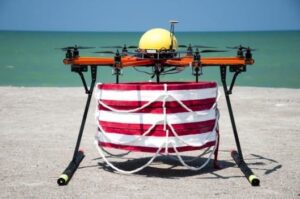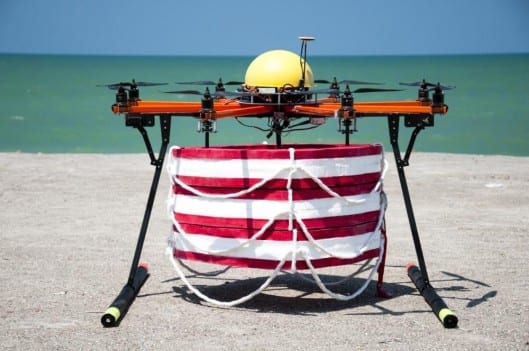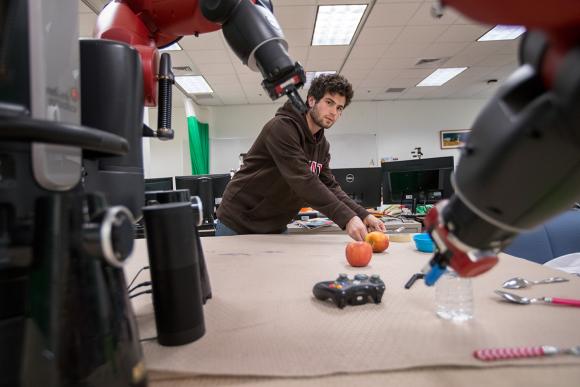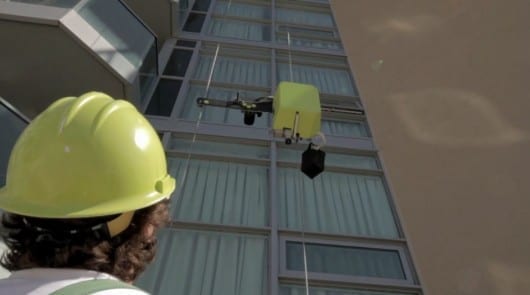
Earlier this year, RTS Lab unveiled its concept for Pars, an aerial robot that flies out over a large body of water to air-drop life preservers near drowning victims.
Like many design concepts, we weren’t sure if this life-saving drone would ever become a reality, but it seems the Iran-based company was recently able to fund a working prototype and even test its capabilities in open water. Based on these initial tests, it’s possible that this flying, GPS-guided lifeguard could be out there saving lives sooner than you think.
Over the course of four days in August of this year, the Pars development team visited the Caspian Sea to conduct a battery of tests on its brand new prototype. The location was chosen in part for its proximity to the RTS lab, but also because it’s been the site of several tragic drownings in the past few years, including an incident that took the lives of six students this past summer. Among other attributes, the team tested the Pars’ stability during flight, the accuracy of the life preserver release mechanism, and the bot’s performance in both day and nighttime conditions. According to the researchers at RTS Labs, the prototype bot met their expectations perfectly.
The Pars was able to fly for 10 minutes at a top speed of 10 m/s (22.4 mph) before needing to recharge. This gives it a maximum range of 4.5 km (2.8 miles), making it ideal for emergencies occurring along coastlines and near ships at sea. It also proved to have a distinct advantage over its flesh and blood counterparts, since it can bypass treacherous waters with ease.
When conducting a trial rescue mission, the drone was able to reach a target 75 m (246 ft) away and drop its payload in about 22 seconds, while a human lifeguard took 91 seconds to swim to the same location. During testing at night, the Pars was also able to illuminate targets on the ground and make itself more visible to its controller on land using several bright LEDs.
RTS Lab has pointed out that the drone’s fast speed combined with a capacity for several life preservers means it could attend to multiple people in one trip. With its built-in GPS, it can even be programmed to fly to a certain area, dispense life preservers to anyone in danger, and then automatically return to its base. Of course, the aerial bot won’t be able to pull anyone to safety just yet, but it could be sent out ahead of rescue crews to provide some initial aid. The researchers are also hoping it could give emergency teams a birds-eye view of the situation and help them plot a safe path to where they need to go.
The Latest Bing News on:
Life-saving flying robot
- What it means to dream about flying, according to an experton May 7, 2024 at 1:36 pm
Dreams of flying are symbolic of freedom, liberation and empowerment. They can represent a desire to break free from limitations or constraints in your waking life. Flying dreams may also indicate ...
- Flying Pig Marathon medical team puts out life-saving effort at finish lineon May 6, 2024 at 3:53 pm
His core temperature was 109. A few were at 107.“Life threatening, no doubt,” said UC Health Dr. Jon Divine who is medical director for Flying Pig “What saved those people's lives was the ...
- Flying Life Preservers are Here, But They Cost $12,000on May 6, 2024 at 12:02 pm
The TY-3R, although poorly named, is one of those. Flying life preservers are here. Made by a Chinese company called Didiok Makings, the TY-3R is a relatively simply device. In short, it’s ...
- Boston Dynamics’ robot dog given life-like costume makeoveron May 4, 2024 at 3:23 am
Now named Sparkles, the robot wears a blue dog costume, and has the ability to behave like its real-life counterpart. In a video posted to social media, the original ‘Spot’ robot meets ...
- These Fancy Robot Vacuums Are up to 50% Offon May 2, 2024 at 5:00 pm
increasing battery life and suction power, and improving their companion apps. Here are the best high-end robot vacuum deals available right now. When the Ecovacs Deebot X2 Omni Robot Vacuum came ...
- Flying Forward: Zipline on the Drone Radio Show!on April 30, 2024 at 8:27 am
Don’t miss Zipline on the Drone Radio Show! Keenan Wyrobek and Juan Albanell of Zipline talk about the company’s long-distance Platform 1 delivery service and the company’s plans to scale ...
- Robot bee swarms fly collision-free in close formationon April 29, 2024 at 2:35 am
Even though the BionicBee is Festo's smallest flying robot, you still wouldn't want one or more buzzing around you at a picnic as each measures 220 mm (8.6 in) in length, has a wingspan of 240 mm ...
- 4 Best Robot Mops for Spotless Floors and a Hassle-Free Lifeon April 23, 2024 at 5:00 pm
This year, we've tested a bunch of robot mops and vacuum/mop hybrids (as well as other gadgets), and we found four models that stand out. Bissell's ReadyClean A3 is the most no-nonsense mop of the ...
- His Flying Robots Could Turn Up at Your House When You Dial 911on April 15, 2024 at 12:19 pm
Their informality was a bit jolting, but Resnick started pitching, without much enthusiasm, thinking, "This is 45 minutes of my life I'll never get back." The TikTok manager was interested ...
- Netaboku: A robot girl changes my life as a bedridden boyon April 6, 2024 at 5:04 pm
All the Latest Game Footage and Images from Netaboku: A robot girl changes my life as a bedridden boy This game is a sci-fi romantic adventure(visual novel) modeled ...
The Latest Google Headlines on:
Life-saving flying robot
[google_news title=”” keyword=”life-saving flying robot” num_posts=”10″ blurb_length=”0″ show_thumb=”left”] [/vc_column_text]The Latest Bing News on:
Life-saving drone
- US firm unveils new 500 mph speeding, missile and cargo carrying droneon May 11, 2024 at 7:19 am
South California-based Mayman Aerospace has unveiled its new range of jet-powered, high-speed vertical take-off and landing (HS VTOL), AI-equipped drones. Mayman says that these drones can be used for ...
- A father and son designed the world’s fastest quadcopter droneon May 10, 2024 at 12:12 pm
A father-and-son team recently set a new Guinness World Record for the fastest quadcopter drone, speeding past the previous title holder. After months of fiery trial-and-error, Luke and Mike Bell’s ...
- N.C. county demos AED delivery by drone during simulated emergencyon May 9, 2024 at 7:21 am
The Forsyth County Sheriff's Office flew the drone to a simulated emergency and dropped the AED to the 911 caller ...
- Malawi: Leveraging Drones to Bridge Healthcare Gaps in Malawion May 8, 2024 at 4:10 am
Millions lack access to essential healthcare in sub-Saharan Africa, often due to the tyranny of distance compounded by the growing threats of climate change. Traditional transportation methods ...
- Drones Take Wing for Malawi's Healthcare Needson May 8, 2024 at 1:01 am
Millions lack healthcare access in sub-Saharan Africa due to remote locations and climate challenges. Traditional delivery methods often fall short, leaving vital medicines and vaccines out of reach.
- News On 6 Drone Footage Shows Significant Damage To Barnsdall Homeson May 7, 2024 at 6:46 am
As the sun comes up Tuesday, we are getting a better look at the damage in the Barnsdall area after a tornado moved through overnight.
- The Danville Life Saving Crew sounds like only a rescue group. Its services run far deeper.on May 7, 2024 at 2:00 am
In a four-part series, the Danville Register & Bee is examining the inner workings of the Danville Life Saving Crew, after spending a full day with the deputy chief in early April. The ones who rush ...
- 911 drone takes first flights in Manatee Countyon May 3, 2024 at 3:21 am
MANATEE COUNTY, Fla. — A 911 drone system is taking its first flights in Manatee County this week. As the first of its kind, the system aims to speed up emergency response times and save lives. The ...
- Drones Find Dozens of Landmines Littering Ukraine So They Can Be Defusedon May 2, 2024 at 11:00 am
The AI-armed eye in the sky is already saving people in Ukraine from being killed by landmines and unexploded shells, to be used globally next ...
- This Chinese hybrid drone turns into a lifebuoy to rescue drowning swimmerson April 30, 2024 at 9:44 am
The TY-3R Air-Water Rescue Drone system can rapidly deploy and provide floatation assistance to distressed swimmers in water emergencies.
The Latest Google Headlines on:
Life-saving drone
[google_news title=”” keyword=”life-saving drone” num_posts=”10″ blurb_length=”0″ show_thumb=”left”]











